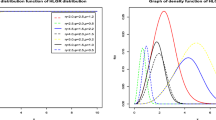Abstract
On the basis of Akaike's Bayesian information criterion (ABIC), a new method of estimating temporal and spacial variations in the magnitude-frequency relation (b value) is developed. The space-time volume studied is divided into a number of segments having equal volume, for which b values are estimated. The smoothness of the estimated b value is guaranteed by the introduction of a prior distribution. The parameters of the prior distribution are chosen in such a way as to minimize the ABIC. This method is employed to study the temporal and spatial variations of b values for microearthquake activity in the Kanto, Tokai and Tottori areas, where seven earthquakes having magnitudes of M6.0 and larger have recently taken place. States of temporal variations of b values are classified into three groups; increase, decrease and nochange. The space-time volume of decrease accounts for approximately 10% of the total volume. For a period before the occurrence of earthquakes, the decrease appears more frequently than might be expected. It is concluded that the decrease in the b value is a promising candidate to act as a precursory phenomena.
Similar content being viewed by others
References
Akaike, H. (1980). Likelihood and Bayse procedure, Bayesian Statistics (eds. J. M. Bernard, M. H. De Groot, D. U. Lindley and A. F. M. Smith), University Press, Valencia, Spain.
Akaike, H. and Ishiguro, M. (1983). Comparative study of the X-11 and BAYSEA procedure of seasonal adjustment, Applied Time Series of Analysis of Economic Data, 17–53, U. S. Department of Commerce, Bureau of the Census.
Hori, S. (1986). The earthquake mechanism of the M6.1 event occurred near the border of Chiba and Ibaraki Prefecture, central Japan on October 4, 1985 and its tectonic implication, Zisin II, 39, 457–468 (in Japanese).
Imoto, M. (1987a). A Bayesian method for estimating earthquake magnitude distribution and changes in the distribution with time and space in New Zealand, New Zealand J. Geol. Geophys., 30, 103–116.
Imoto, M. (1987b). Time-space variations of the magnitude-frequency relation in the Tokai area, Zisin II, 40, 19–26 (in Japanese).
Imoto, M. and Ishiguro, M. (1986). A Bayesian approach to the detection of changes in the magnitude-frequency relation of earthquake, J. Phys. Earth, 34, 441–455.
Ishiguro, M. and Sakamoto, Y. (1983). A Bayesian approach to binary response curve estimation, Ann. Inst. Statist. Math., 35, 115–137.
Li, Q., Chen, J., Yu, L. and Hao, B. (1978). Time and space scanning of the b value—a method for monitoring the development of catastrophic earthquakes, Acta Geophys. Sinica, 21, 101–125 (in Chinese).
Ma, H. (1978). Variation of the b-values before several large earthquakes occurred in North China, Acta Geophys. Sinica, 21, 126–141 (in Chinese).
Ma, H. (1982). The spatial distribution of the b-values before large and moderate earthquakes, Acta Geophys. Sinica, 25, 163–171 (in Chinese).
Matsumura, S. (1984). Evaluation of detection capability of microearthquakes for an observational network—the Kanto-Tokai observational network of the National Research Center for Disaster Prevention, Zishin II, 37, 475–489 (in Japanese).
Ogata, Y. and Katsura, K. (1988). Likelihood analysis of spatial in homogeneity for marked point patterns, Ann. Inst. Statist. Math., 40, 29–39.
Ohtake, M. (1986). Synchronized occurrence of offshore and inland earthquakes in the Ibaraki region, central Japan, Earthq. Predict. Res., 4, 165–173.
Robinson, R. (1978). Seismicity within a zone of plate convergence—the Wellington region, New Zealand, Geophys. J. Roy. Astron. Soc., 55, 693–702.
Sakamoto, Y., Ishiguro, M. and Kitagawa, G. (1983). Akaike Information Criterion Statistics, 290 pp., Reidel, Dordrecht.
Scholz, C. H. (1968). The frequency-magnitude relation of microfracturing in rock and its relation to earthquakes, Bull. Seismol. Soc. Amer., 58, 399–415.
Shibutani, T. (1989). On features of spatial and temporal variation of seisimicy before and after moderate earthquakes, J. Phys. Earth, 37, 201–224.
Smith, W. D. (1986). Evidence for precursory changes in the frequency magnitude b-value, Geophys. J. Roy. Astron. Soc., 86, 815–838.
Udias, A. (1977). Time and magnitude relations for three microshock series near Hollister, California, Bull. Seismol. Soc. Amer., 67, 173–185.
Wyss, M. and Lee, W. H. K. (1973). Time variations of the average earthquake magnitude in central California, Stanford Univ. Publ. Geol. Sci., 13, 24–42.
Author information
Authors and Affiliations
Additional information
This work was carried out under the ISM Cooperative Research Program (88-ISM CRP-60).
About this article
Cite this article
Imoto, M. An application of Bayesian (ABIC) smoothing methods to estimating space and time variations in the magnitude distributions of earthquakes. Ann Inst Stat Math 43, 207–225 (1991). https://doi.org/10.1007/BF00118632
Received:
Revised:
Issue Date:
DOI: https://doi.org/10.1007/BF00118632




